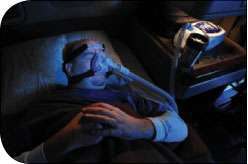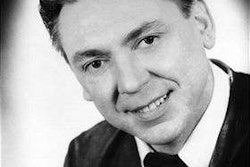
Below you’ll find the language of the 10 recommendations, and I thought I’d also share here some statistics that the Owner-Operator Independent Drivers Association has put together relative to the potential total cost of treatment of drivers under the 35 BMI testing mandate proposed. These costs are estimated at a $180 million total annual cost to the industry. That’s the testing alone. Granted, it assumes an average $2,500-$3,000 figure for an in-lab sleep test, which sleep specialists note has fallen somewhat in recent years. (However, in public comment near the end of the meeting yesterday, former small fleet owner — and current school bus fleet owner — Donald Fowler, of Richmond, Mo., referenced an October sleep study he himself had that was billed, all told, at just shy of $2,000.)

Furthermore, in a member survey OOIDA conducted, 72 percent of operators said their medical policies would not cover sleep apnea expenses. An argument OOIDA’s Todd Spencer and others made today, too, demonstrated something of a safety net loss if a large number of experienced operators are in fact forced out of the industry by the regulation (the OOIDA stats estimate 12 percent of the 3.5 million or more CDL drivers have BMI above or equal to 35) and are replaced by a less-experienced group, naturally more prone to making on-highway mistakes.
That’s all of course not counting the time and miles lost to downtime during testing, which for some operators could be significant if their apnea problems turn out to be significant themselves — some operators concluded to have apnea would be disqualified until treated. See below for specifics.
Another interesting part of the proceedings was the fact the final recommendations from the subcommittee on acceptable areas of treatment put the most confidence in continuous positive airway pressure (CPAP) machines, not least due to the ease of monitoring that is in place in current devices. This came in spite of dental practices in existence today that specialize in sleep medicine, as some of you I know are already well aware of. Midwest Dental Sleep Center’s Scott Craig, of Woodridge, Ill., characterized the exclusion of dental treatment of apnea in the recommendations as a mistake that is the result of the lack of a dental specialist on the FMCSA’s Medical Review Board. “Currently there are commercially available products to monitor compliance,” he said, showing me the Smart Retainer device by Scientific Compliance as an example.
The manufacturer inserts electronic temperature sensors into dental retainers in order to allow doctors to scan the device to retrieve information about use and other data.
MRB members effectively dismissed much of the literature on studies relating to dental appliances as non-objective, borderline “commercials,” one said.
MCSAC member and Texas-based Clark Freight Lines’ Danny Schnautz put in his objection to the exclusion of the devices. Schnautz could well see such devices’ potential attraction to drivers who might otherwise need to idle their trucks to ensure power to a CPAP machine and truck starting power overnight. “I think we might be shutting the door tighter than we should have,” he said, making reference to language in the MCSAC recommendations that state dental devices’ “long-term efficacy” cannot “be demonstrated currently, so these technologies are unapproved alternatives at this time.”
Full language of the recommendations as I best followed their drafting/revision follows. (Note: there may be further revision as yet before they are sent formally to FMCSA, though their intention as outlined here should largely remain. Italics represent committee annotations about intentions.)
RECOMMENDATION LANGUAGE:
Recommendation 1 — General
- Obstructive sleep apnea (OSA) diagnosis precludes unconditional certification.
- A driver with OSA diagnosis can be certified if:
- The driver has untreated OSA with apnea-hypopnea index (AHI) < 20 (i.e., mild-to-moderate OSA) AND
- The driver does not admit to experiencing sleepiness during the major wake period OR
- OSA is being effectively treated.
A driver with an OSA diagnosis may be recertified annually, based on demonstrating compliance with therapy.
- Minimally acceptable compliance with PAP means at least 4 hours/day of use 70 percent of days.
- § Drivers should be encouraged that more hours of PAP use is preferable.
- § Optimal treatment efficacy occurs with 7 hours or more of daily use during sleep.
- The intent behind the AHI threshold is to prioritize those drivers with OSA that need immediate treatment.
- Drivers with mild OSA (AHI levels as low as 5) may benefit from OSA treatment, and should be encouraged to explore treatment options.
- Drivers with an AHI between 5 and 20 should be encouraged to seek treatment, if they have a history involving a fatigue-related crash or a DOT-defined single vehicle crash [footnote reference: crash involving a CMV that results in a fatality or injury treatable away from the scene or disabling damage requiring tow away], or if they report sleepiness while operating a motor vehicle.
- Why set the AHI threshold at 20?
- Crash risk in the moderate-to-severe OSA range is statistically higher than for drivers with mild OSA.
From a practical perspective, setting the AHI limit at 15 or above makes it more difficult to get a patient under treatment to that AHI level. Although AHI of 15 is likely a safer threshold, there is not data to show this.
RECOMMENDATION 2 — Drivers with any of the following should be disqualified immediately or denied certification:
- Report excessive sleepiness during the major wake period while driving, OR
- Experienced a crash associated with falling asleep, OR
- Have been found non-compliant in treatment per Recommendation 1.
RECOMMENDATION 3 — Drivers with any of the following may be granted conditional certification per Recommendation 4:
- Have AHI > 20 until compliant with PAP, OR
- Have undergone surgery and are pending post-op findings per Recommendations 10-12, OR
- Have a BMI > or equal to 35 kg/m2 (pending sleep study).
Notes:
- BMI cutoff of 33 is supported by studies (MRB).
- BMI cutoff should be objectively related to crash risk (Conway).
RECOMMENDATION 4 — Conditional certification
- Driver with BMI > or equal to 35 kg/m2 may be certified for 60 days pending sleep study and treatment (if diagnosed with OSA).
- Within 60 days, if a driver being treated with OSA is compliant with treatment (per Recommendations 8-12), the driver may receive additional 90 day conditional certification.
- After 90 days, if the driver is still compliant with treatment, the driver may be certified for no more than 1 year. Future certification dependent on continued compliance.
Refer to Recommendation 1 for definition of minimal compliance. [Insert clinical evaluation educational footnote]
[CLINICAL EVALUATION EDUCATION FOOTNOTE]
- Medical examiners should screen all drivers for OSA.
- The driver is judged at-risk for OSA based on:
- The driver’s answers to a validated questionnaire (e.g., Berlin), OR *Some other validated screening tool.
- Symptoms: loud snoring, witnessed apneas, sleepiness during major wake period.
- Risk factors may include the following. A single risk factor alone may not infer risk. Need to look at multiple factors.
- Factors contributing to high risk
- Small or recessed jaw
- Neck size > 17” male, 15.5” female (strongly correlated with obesity, which is associated with sleep apnea)
- Other factors
- Age 42 and aove
- BMI > 28 kg/m2
- Small airway (Mallampati Scale score of Class 3 or 4)
- Family history
- Male or post-menopausal female
- Experienced a single-vehicle crash
- Conditions associated with high risk:
- Hypertension (treated or untreated)
- Type 2 diabetes (treated or untreated)
- Hypothyroidism (untreated)
RECOMMENDATION 5 — Method of diagnosis and severity
- Methods of diagnosis include in-laboratory polysomnography, at-home polysomnography OR a FDA-approved limited channel ambulatory testing device which ensures chain of custody.
- In-laboratory polysomnography, which is more comprehensive, should be considered when the clinician suspects a sleep disorder in addition to sleep apnea.
- Note that new technologies will likely emerge that will be able to screen for OSA.
- Driver should be tested while on usual chronic medications.
- Note that the joint medical committee did not consider AHI levels from unattended studies, but only in-lab sleep studies, which detect the arousal component of hypopneas (not just saturation).
- An in-home sleep study may underestimate AHI when compared to an in-lab sleep study.
- An AHI detected on an in-home sleep study may be less than an in-lab study because the in-home study likely does not consider total sleep time.
- Therefore, the medical examiner should use clinical judgment when interpreting results of an unattended sleep study.
- If the clinician believes the level of apnea is greater than the level reported by the in-home study, the clinician should consider recommending an in-laboratory sleep study.
RECOMMENDATION 6 — Treatment, PAP
- All individuals with OSA should be referred to a clinician with relevant expertise.
- PAP is the preferred OSA therapy.
- Adequate PAP pressure should be established through one of the following:
- Titration study with polysomnography
- Auto-titration system
A driver who has been disqualified may be conditionally certified (per Recommendation 4) if successfully treated for 1 week AND
- The driver can demonstrate at least minimal compliance (4 hrs/use 70% of nights) AND
- The driver does not report excessive sleepiness during major wake period.
RECOMMENDATION 7 — Treatment alternatives
There are limited data regarding compliance with and the long-term efficacy of dental appliances cannot be demonstrated currently, so these technologies are unapproved alternatives at this time.
Surgical treatment is acceptable (see Recommendations 10, 11 and 12).
RECOMMENDATION 8 — Bariatric surgery
After bariatric surgery, a driver may be certified if:
- Compliant with PAP, OR 6 months have passed since surgery (for weight loss), AND
- Cleared by treating physician, AND
- No reported excessive sleepiness during major wake period.
- After six months have passed since surgery, a repeat sleep study may be considered to evaluate for the presence of ongoing sleep apnea.
Annual recertification
- Maintain stable weight
If clinically indicated, repeat sleep study.
RECOMMENDATION 9 — Oropharyngeal surgery, facial bone surgery
After oropharyngeal or facial bone surgery, a driver may be certified if:
- 1 month has passed since surgery, AND
- Cleared by treating physician, AND
- No reported excessive sleepiness during major wake period.
After 1 month has passed since surgery, if the apnea appears to have resolved, a repeat sleep study should be considered to test for the presence of ongoing sleep apnea.
Annual recertification
- If clinically indicated, repeat sleep study.
RECOMMENDATION 10 — Tracheostomy
After tracheostomy, a driver may be certified if:
- 1 month has passed since surgery, AND
- Cleared by treating physician, AND
- No reported excessive sleepiness during major wake period.
After 1 month has passed since surgery, if the apnea appears to have resolved, a repeat sleep study should be considered to test for the presence of ongoing sleep apnea.
Annual recertification
- If clinically indicated, repeat sleep study.













